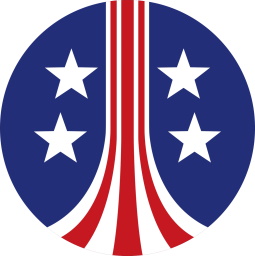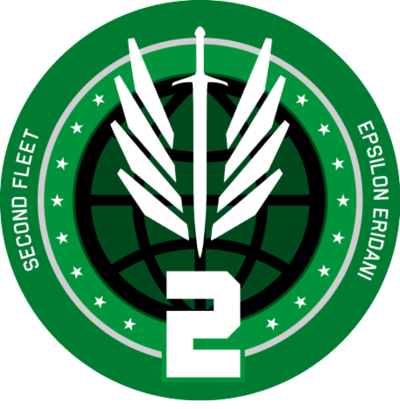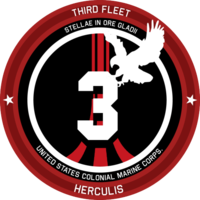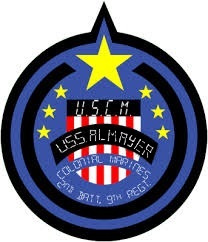More actions
United States Colonial Marines
The USCM is divided into three overarching branches, called the Marine Space Forces: Sol, overseeing the core colonies and earth, the largest of the three; Eridani, operating among the Chinese and American colonised arms; Herculis, going through the Anglo-Japanese arms and the outer fringes. Each branch operates independently, but all are responsible for protecting American space territory and working together in that goal. There is also a fourth group, the Reserves, which is stationed mostly on earth and serves to reinforce the other branches. They have not seen any active use yet, but who knows what the future holds.
Marine Space Force, Herculis, Chinook 91 GSO station is a military space station in geosynchronous orbit around the colony world Georgia 525 (70 Ophiuchi A V), and is the headquarters for the Herculis branch of the USCM. Under its control are the 4th Colonial Marine Division, 4th Colonial Marine Brigade, 4th Aerospace Wing, and 1st Colonial Support Group of the USCM. Chinook 91 reports directly to O'Neill station in Earth-Lunar space. The O'Neill station is the main communication base between the three branches. Supervising orders from the homeworld, controlling the First Fleet and rare joint operations. It is an extremely vital station and well guarded by the First Fleet in all its might. Tithonis Mountain on Bernice 378 is another large garrison of USCM troops, such as the 1st Colonial Support Group, and there are more minor garrisons along the Anglo-Japanese arm. The 2nd battalion of the 4th brigade, the Falling Falcons, and the USS Almayer are stationed in Herculis.
Fleets
Fleet insignias were made by Naut.
Almayer
The USS Almayer, an Arikara-class patrol transport, was christened in 2171 but designed in the 2150s during an increased need for patrol craft in deep space. The first Arikara-class patrol transports were constructed in the 2160s, and the USS Almayer was the 4th ship in the class produced. The USS Almayer was constructed in the Heinlein Memorial Shipyards located above the Earth’s Moon for low gravity workstations. The main advantages of the Arikara patrol transport over other forms of transports and combat ships, is its small footprint and rapid response time. However, the marines that serve aboard these patrol transports are either volunteer forces or conscripted. These forces are subject to long voyages in outer territories where most luxuries do not exist, while lacking proper training and supplies.
The USS Almayer underwent a Block 78A retrofit in 2178, which replaced many of the sensors and maintenance areas. Along with that, due to rising tensions between Weston-Yamada and various outer rim colonies. The need arose to include a Corporate Representative onboard, or so goes the official reports. The sum for this service was never officially disclosed, but the USS Almayer was equipped with an office for a Company Representative and sent to patrol corporate outer-rim colonies. For more information on the USS Almayer head here.
History
The USCM was created following the passing of The National Security Act of 2101. The act authorizing the formal formation of four combat divisions and four aerospace wings, plus the support services organic to these formations. Its task was primarily assigned to the defense of the growing colonial frontiers of the United States government. The frontier had grown during the Great Space Race, involving the three major powers of Sol, all attempting to spread their grasp across the stars. The marines would serve as a defensive and reactionary force rather than an offensive one.
It was not until after the Sol Campaign, that the American military and government made use of the USCM as an offensive might, using it to wrest control of the colonial frontier through force. Their Mars and Sol colonial assets shaken due to UPP proxy funding, and an ignited civil unrest that led to a full sized conflict costing thousands in Sol. This led to a belief for the UA that a similar fate would befall the American colonies which were farther from the reach of the standard army. The belief quickly led to the rapid mobilization and armament of the USCM, along with the adaption of unrestricted military doctrine on civilian colonies. The result caused the ignition of Operation Canton.
Operation Canton became the USCM's first offensive deployment, tasked with retaking the colony of Canton whose colonial government was overthrown in a social coup supported by the Union Of Progressive People in 2165. The number of marines peaked at 240,000 active combat Marines and over a dozen combat warships, resulting in one of the largest conflicts fought between two major super-powers in decades. Eventually both sides withdrew after the usage of nuclear weaponry, devastating the colonial population and leaving scars that would echo and become rallying calls for future colonies against falling under the banner of either power.
Current day, the number of active combat marines have dropped to 165,000, with a further 50,000 in reserve stretched across the three sectors of Sol, Eridani, and Herculis. The USCM finds itself locked in a war on insurgency mainly in Herculis with everyday seeing another colony on the frontiers go dark due to an unseen enemy, or another colony declaring itself independent and aligning itself with the loose conglomerate known as the Colonial Liberation Front. As a result of the growing concerns during the Cold War against the UPP, most military funding has been directed inwards to Sol and the inner colonies of Eridani, leaving much of the USCM forces and warships in Herculis either outdated or retrofitted. The situation only continues to grow worse with new enemies appearing daily and insufficient funding and manpower to meet the threat head-on.
Events
Sol Campaign
Regarded as one of the largest wars humanity has seen since the Great Wars of the early 21st century. The Sol War was the first major interstellar war fought between the colonial government of Mars, secretly backed by the UPP, against the UA and RESS forces. The aim was to overthrow their administrative grasp on the massive colony. The total casualties still remain unaccounted for to this day, but body estimates fall into the high millions and also thousands of naval vessels were lost, while trying to take control of space above and secure vital naval ports.
Most casualties are accredited to failure in adapting more modern military doctrine when dealing with multi-planetary conflict. The first wave of reinforcements that was sent to put down the Mars Rebellion, resulted in the loss of over 300,000 soldiers in the first week due to poor coordination. This was due to the failure to disable planetary anti-warship batteries, and fighting against an enemy on their homeland and home space. As a result, Mars forces were able to mobilise defences across the colonies, turning what was anticipated to be a quick war into a long gruelling conflict stretching over four long years.
The War eventually came to a close with the capital of both UA and RESS colonies' captured and colonial government leaders subdued. However, the scars would remain, even to the modern day. Leading to major humanitarian issues, children of dead families caught in the conflict, and a still recovering economy. Mars was permitted to create its own self-defence force, in order to present them a sign of friendship, however it remains severely underfunded with a limit of how many naval vessels and soldiers it may keep in its rosters.
Slaughter of Xibou
The Slaughter of Xibou was a disasterous campaign for USCM and has even been accredited as the spark that ignited CLF. The mission plan was to take down a local colonial freedom fighter. The freedom fighter had managed to convince the planet of Xibou to declare independence, and this action forced the hand of USCM to make an example. The end result was countless dead colonists, which were by far largely innocent. The USCM had to go through several political coverups and not much of this affair is publicly known. Details shrouded in mysteries and information buried deep in archives. The precise reason as to why it ended in such a tragedy is unknown.
Operation Canton
Operation Canton was the first major conflict that USCM was deployed into, since the Sol Campaign pressured congress to bolster their funding and recruitment. The colony world of Canton suffered from a socialist-led coup, resulting in overthrowing the UA-supported government and the installment of a pro-UPP regime. American Government and USCM High Command, already haboring a deep distrust in the colonies, wasted no effort in mobilizing and deploying a massive task-force. The task-force being solely dedicated with retaking the colony by force. The UPP also not desiring to lose the opportunity to get their hands on a rich colonial world deployed their own task-force, resulting in the first major engagement between the two super-powers since the start of the Cold-War.
The Operation was extremely bloody, most notably for the civilians caught in the crossfire. The USCM had already gained a sour reputation among colonial worlds due to rumored massacring of civilians. There was also a deep dislike for the colonies by veteran officers who had served in the Sol Campaign. They foresaw Canton as the second Sol Campaign and therefore permitted marines off the record to fight unrestricted, regardless of civilian life caught on the battlefield, in order to prevent such a disaster from occuring in American history a second time. Some historians argue these cruel stances by High Command as a result of nervousness and desire to protect more American lives, however others saw it as a sole desire to uphold American hegemony through an iron fist.
The end of the conflict was the usage of nuclear weapons and withdrawal of both of the UPP And USCM forces after years of battle. The conflict failed to see a winning side with most of the colony now in ruins and referred to as 'unusable'. After the full withdrawal, a humanitarian relief force was assembled and said to have been sent to aid those left in the aftermath. However, little money actually went to the relief force. In the end after the media had blown over the incident and forgotten it. The relief force was eventually disbanded and the planet left on its own. The disaster quickly became the first rallying call for a rise to action with the belief of 'Fend for ourselves' mentality.
Divisions
Standard
Military Police
Officers
Relations
| Factions | Connections |
|---|---|
 UPP UPP
|
The Union of Progressive People and the United Americas have been locked in a Cold War for decades. Since the end of the Great Space Race and military conflicts such as the Sol Campaign and Operation Canton, movement and amassing of military forces along borders has not been uncommon. Various skirmishes between the two are common, but undisclosed to the public, as the result could escalate into a full-scale nuclear war. |
 CLF CLF
|
The Colonial Liberation Front are the USCM's primary enemy in the Tychon's Rift Sector. Their ideology opposing the American Government which they believe have long since abandoned the colonies. As a result, they wage a fierce guerrilla war on the Marine forces. Although under-equipped and undermanned compared to their marine enemy, they have made up for such lacking with strategic hit-and-run tactics which have proved devastating in the war of attrition with the under-funded USCM forces in the sector. |
| The USCM purchases equipment from Weston Yamada in great numbers and is very close allies with its founding country the Royal Empire of the Shining Sun. However, suspicions continue to be raised surrounding the disappearance of USCM vessels and colonies on the far frontiers and traces have continued to lead to Weston-Yamada itself, straining relations intensely. | |
| File:RESS Patch.png RESS | The RESS maintains a firm but uncertain alliance with the USCM and its UA government since the early rise of the UPP and colonization of the stars. Both powers have competed for colonial expansion, such as on Mars where the planet was split between the two major powers. The end of the Sol Campaign marked the first major rift between the two as both attempted to redraw the territorial lines creating fierce tension between the monarchy and democratic nation. The USCM only grows more wary due to RESS having close ties to WY whom the military is suspicious of, creating an even greater rift between and aiding in the crumbling of relations. |
Links
| Major Factions | |
|---|---|
| Minor Factions | |
| Ships | |
| Maps | |
| Species | |
| Stories |






















